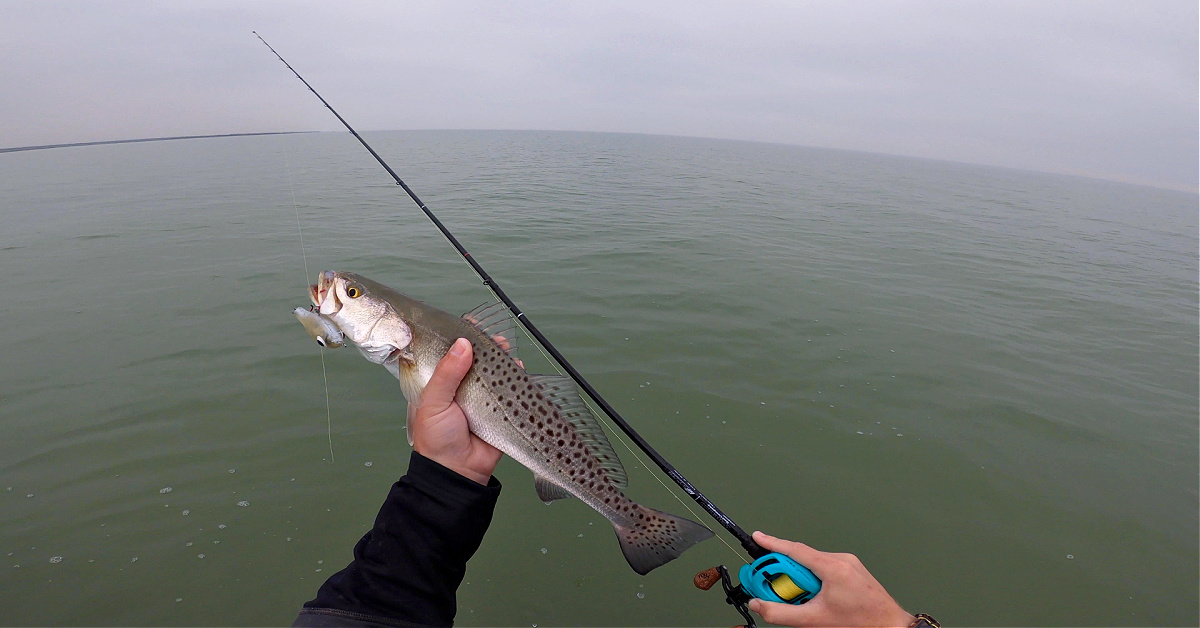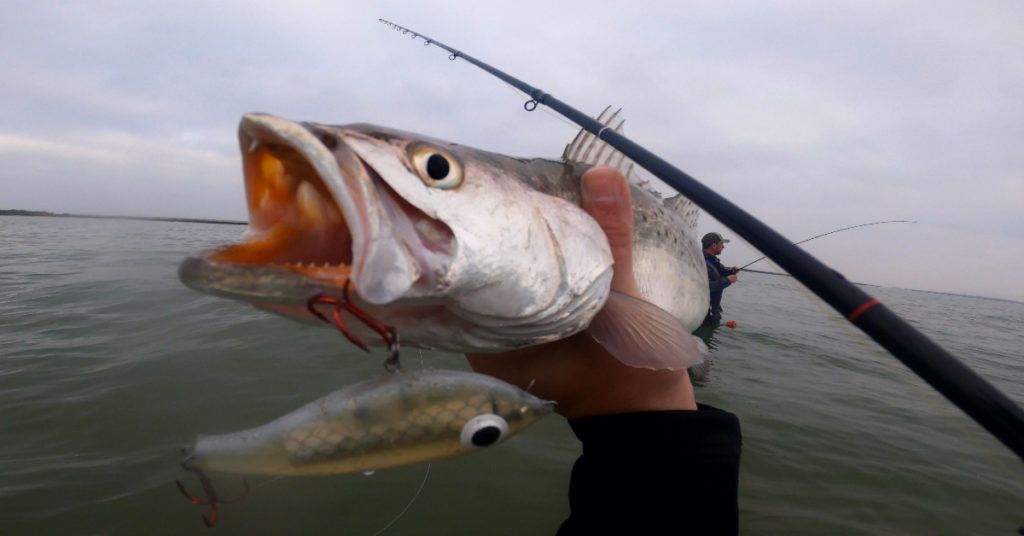How To Catch Speckled Trout After A Huge Winter Storm
- By: Wyatt Parcel
- on

How do you catch speckled trout after a winter storm?
A MAJOR winter front came through Texas just a few weeks ago and left me wondering where the fish would move after.
So I hit the water with a buddy of mine to find out!!
How To Catch Speckled Trout After A Winter Storm [VIDEO]



I hit the water with the 13 Fishing Concept TX Gen II Baitcasting Reel and my trusted Corky lure.
I’ll be fishing with this outfit for the last remaining weeks of winter and the first few weeks of spring.
I’ve mainly used spinning gear, but since moving to Texas I have been convinced that baitcasting reels are ideal for Corky fishing.
It is a bit more efficient and less taxing on your arms.
To start, we tossed our Corky lures out to feel the depth changes and the ledge of a protected shoreline to our left.
Some bites came real quick but I’m new to the baitcasting reel and still getting familiar with hooksets.
Eventually, I figured it out and reeled in some smaller trout to start.
Keep in mind, we are targeting these fish where they feel they will be protected by the fronts.
The wind shifted from north to south and the fish began to warm up.
Corky Lure Retrieve
In my experience, Corky lures also convince fish to come back for a second or even third strike after the initial hit.
If a fish strikes your lure but misses, don’t reel it in right away.
Continue to work that lure as you would and that fish could come back for a second swipe.
Lots of times, I use the same cadence and walk as a topwater lure retrieve.
That same mindset to continue working your lure after a topwater strike applies to the Corky.
The ultimate goal is to obviously get your Corky in the strike zone.
That might sound simple, but the Corky will help you locate the exact strike zone.
Are strikes coming near the surface, middle of the column, or on the bottom?
Are fish responding to faster retrieves, normal retrieves, or a super slow retrieve speed?
These are the kinds of questions you should ask yourself on the water.
Cast the Corky out and let it sink to the bottom.
Then make several, very fast pops with the rod.
That causes the lure to dart around and twitch to imitate baitfish behavior.
Right after those aggressive pops, take a pause for several seconds.
On this trip, the fish responded to about a 3-5 second pause but that will vary on other days.
The Corky sinks on the faster side so you do want to have a count of how long it takes to get to the bottom.
If you’re catching grass or getting snagged, reel in a bit sooner on the next cast and you’ll know how long you need to let it sink.
A lot of the fish on this trip had mites on their bellies which tells us they’re sitting on the bottom.
You will have to make slight adjustments throughout the day to see what the fish are dialed into.
Finding where the fish are and at what depth they’ll strike is most important.
Corky Lure Colors
The overcast on this day and the heavy fog made me lean toward using a white Corky.
Changes in color conditions throughout the day and moderately clear water were mostly why I chose to go with white.
Not just for the Corky, but for any inshore saltwater fishing lure, white is an all-around color that can trigger strikes in most scenarios.
If you’re fishing with constant changes in light conditions and overcast ahead, white is your best bet to spark a bite.
As a built-in bonus as well, the white matches the color of the mullet which is the primary food source right now.
Moreover, you want to have a slight bend in the tail of the Corky to work those deeper zones.
How Can You Catch ONLY The Bigger Trout?
My first recommendation is that you probably should move spots.
If you’re out catching small schoolie trout like Ryan and me on this trip, then you definitely want to move.
The 25in+ trout are not hanging around schools of smaller trout.
More than likely, these schooled-up trout are together for protection against larger predators and they will hunt as a school.
These fish do not yet know how to be independent.
The larger trout are a bit more solitary.
So Ryan and I were trying to find the edges of these schools and work those areas a bit slower to see if a gator trout was hanging nearby.
The big fish on this trip came after we moved down the shoreline away from the larger schools of small trout.
Another thing to make note of is the larger fish were all in the shallows.
Something you can start doing immediately is moving a few feet shallow.
It’s all about trying to predict where the easy meals for big fish are going to be.
Conclusion

This trip is an excellent example of how the fish feed in the wintertime and why they favor larger bait presentations.
I caught my biggest fish of the trip in the shallowest water I could find!
Keep your presentations on the larger side, focus on your retrieves, and FIND SHALLOW WATER!!!
Want the 90/10 Fishing Recipe for YOUR local area?
Get your Custom 90/10 Recipe HERE!

Finding The Fish Help
In order to help make sure that you are targeting the right areas based on the latest feeding trends and upcoming weather forecasts, make sure to use the following 3 resources because they will save you a ton of time.
1. Weekend Game Plans (updated weekly)
These regional game plans will show you exactly what types of spots to target in under 10 minutes… just click the video to start, and you’ll be informed on what to do on your next trip.
2. Smart Fishing Spots Platform (updated every 15 minutes)
This exclusive software literally shows you where the most fish are likely to be feeding based on exactly when you’ll be fishing. It factors in the tides, wind, and weather to help you quickly see which areas to target throughout the day.
3. Community Reports (live feed)
The Insider Community platform is what you can use to see what is biting near you, and you can get to know other members who fish in your area. Plus, you can use it to keep a log of your catches so you can use past trips to help predict future catches.
Related categories:
STOP WASTING TIME ON THE WATER!
Do what the “SMART ANGLERS” are doing and join the Insider Club.
Here’s what you’ll receive today when you join:
- Weekly fishing reports and TRENDS revealing exactly where you should fish every trip
- Weekly “spot dissection” videos that walk you through all the best spots in your area
- Exclusive fishing tips from the PROS you can’t find anywhere else
- Everything you need to start catching fish more consistently (regardless if you fish out of a boat, kayak, or land).










Growing up in Texas the corky fat boy was always my go to. It works just as well in Florida. All my fishing buddy’s use it now too. Tried true and proven. Personal best trout in FL 13lb 12oz
Epic!! A 13lb trout is BEASTLY!
That was Very informative, very curious why you picked the Waterloo SlamMag?
What rod was Ryan Using?
It was the rod that matched the power for what I needed to throw heavier lures (corkies) with, and the action to set the hook and fight trout properly (extra fast allows for good hooksets in soft mouths and gives more room for error when they come to shake their heads).
Very nice Wyatt! Always enjoy your posts. Love the Corky and MR 17. They say the corky is responsible for most of the biggest trout caught in Texas. (Especially in tournaments). Is that true?
Yes! They’re probably the most commonly used lure in trout tournaments where artificial lures are required!
Thanks for the detail on the Corkys. Keep hearing people talk about them & didn’t know this stuff. Do you replace the trebles with inlines & if so generally what size?
I have stopped replacing them with inline hooks because I prefer the action with the trebles.
Great video Wyatt. You guys had plenty of action. I will rewind and watch again as there is a lot of information to digest. Thanks for the help.
Absolutely! Thanks for watching Terry!!